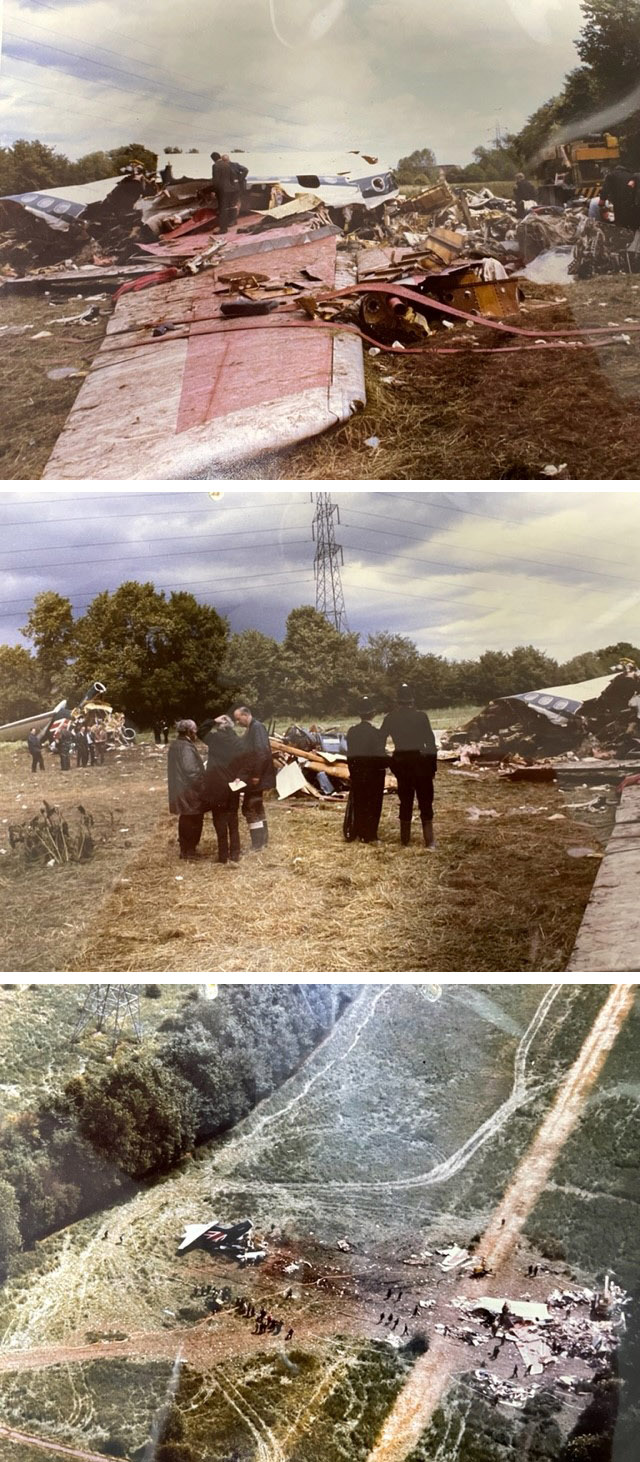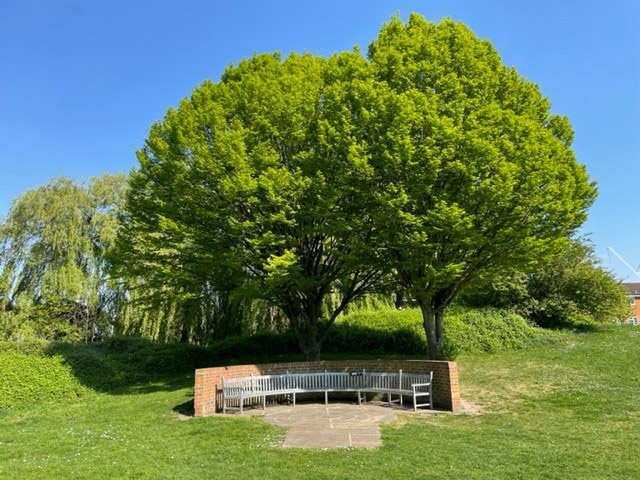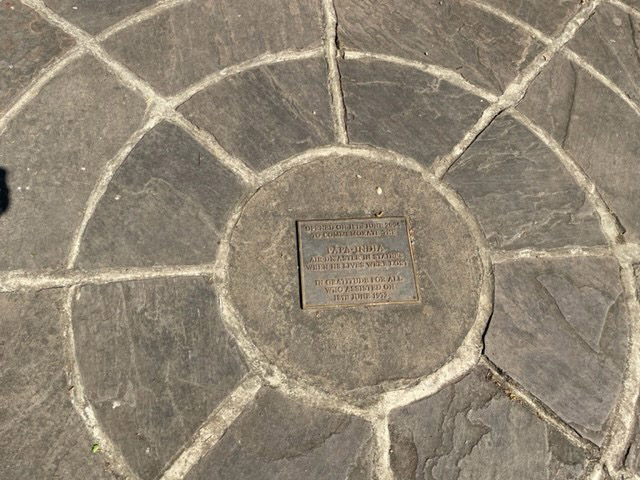It is incredible how many people seem unaware of the Staines air crash, which happened 50 years ago today. British European Airways (BEA) flight 548 remains the deadliest air accident to have taken place in the United Kingdom, killing all 118 people on board. Pan Am Flight 103, which crashed 16 years later in 1988 and claimed the lives of 259 people, killed more people, but this was as a result of terrorist action and became known as the Lockerbie bombing.
The National Archives houses the reports on the accident which took place on the afternoon of Sunday 18 June 1972, together with statements from witnesses and radiotelephony transcripts. The document DR 11/74 includes correspondence up to December 1972, but the Official Report of the Public Inquiry into the causes and circumstances of the accident was not published until nearly 10 months after the accident on 14 April 1973.
I moved to Staines in September 1998 and its locality to Heathrow Airport is immediately apparent – Terminal 5, which didn’t open until March 2008, is less than four miles away from the centre of the town.
BEA Trident 1 aircraft G-ARPI was referred to as its call sign ‘Papa India’ throughout the reports. It crashed in a field near Staines at 16:11, less than three minutes after taking off from London Heathrow airport en route for Brussels on a scheduled flight. All those on board died – three pilots, two stewards, one stewardess and 112 passengers.
A total of 103 eyewitnesses gave evidence as to the circumstances of the accident and their statements were taken by the police. Some of the witnesses claimed that they saw the aircraft take off and that its behaviour at that time was unusual in various respects. For example, it made an unusually long takeoff run and its initial climb angle was less steep than normal. Eighty-two witnesses saw the aircraft before it crashed and most commented on the loudness of the engines, one describing it as ‘choky’. The aircraft was seen by the majority of witnesses, most of whom were in cars travelling along the A30, to appear out of cloud over the George VI reservoir, heading towards Staines. Most were agreed that the aircraft was ‘clean’ underneath and that its undercarriage flaps were retracted. All witnesses commented on the steepness of the descent and the total absence of aircraft noise. The aircraft was then seen to disappear behind trees, and the shock of the impact was felt by a number of witnesses.

By 16:20 there was a rapid build-up of police and emergency services at the scene. There was initially one survivor but he died from his injuries shortly after arriving at nearby Ashford Hospital.
The report concluded that there was no major mechanical malfunction involved with the aircraft and that it was a result of pilot error, identifying three key reasons for failing to recover from the deep stall which led to the subsequent crash: inattention or distraction, lack of training for subtle incapacitation, and inexperience. It was also noted that the Captain had an abnormal heart condition which may have led to a lack of concentration and impaired judgment. Furthermore, there was an ongoing union dispute which had divided opinions among pilots, and there was evidence of heated exchanges on the ground among pilots on the day of the crash.
The report made a number of recommendations, mainly around training and instruction for pilots but also that the carrying of cockpit voice recorders should be a mandatory requirement on all civil passenger-carrying aircraft. Unfortunately, there was no cockpit voice recording on the fatal flight, leading to a certain degree of uncertainty with regards to what actions were actually taken and by whom.
On board the aircraft were 28 Britons, 29 Americans, 29 Belgians, 12 Irish, four South Africans, three Canadians, one Thai, two Jamaicans, one Latin American, one Indian, one French Afrique and one Nigerian.
The deaths included 12 of Ireland’s most prominent businessmen, who were on their way to Brussels for discussions at the EEC headquarters following the passing of the referendum allowing Ireland to join the Community. Ireland, together with the United Kingdom, acceded to membership the following year.
Thirty-two years after the disaster, in 2004, a memorial bench and plaque were erected in Waters Drive, Staines, where a service is held every year to remember those that died. Fifty years on, we remember all those victims today.


An interesting article.
Reference is made to a lack of training for “subtle incapacitation” being one of the possible causes of the crash. Presumably this speaks to seemingly minor health conditions – is this the case and if so, can you provide examples of the types of health condition that should no longer cause a problem as a result of improved training of flight crews.
Of course air disasters such as happenned at Staines are mercifully rare; the only other aircrash, not associated with a terrorist act, that I can recall in the UK with large loss of life was at Kegworth in January 1989, in which 47 people died.
What a mercy the aircraft landed in a field and no local lives lost in addition.
Ruth Kershaw
An interesting post as always – although I find it hard to believe this tragedy happened half a century ago.
Like the author I recall the incident, but from news reports at the time, many of which – if I recall correctly – criticised motorists for slowing down on nearby roads to look at the scene (the implication being that this had delayed rescue services).
I also seem to remember a report of graffiti found in the cockpit wreckage that was related to the strike.
There is also a memorial tree and plaque in Brussels commemerating the accident.
In the days before Mcc, it took years for people to banish the thought that the Captain was infallible and master under God.
As Richard Kershaw remarks non-terrorist fatal air incidents in the UK are rare.
However we should not overlook the fire at Manchester airport in which 55 individuals lost their lives when an engine caught fire on an aircraft shortly before take-off.
‘Pan Am Flight 103, which crashed 16 years later in 1988 and claimed the lives of 259 people, killed more people, but this was as a result of terrorist action and became known as the Lockerbie bombing.’
At the risk of being pedantic, the Pan Am flight did not crash as such. The explosions in the hold area happened at 31000 feet rather than with the ground.
A very good blog, Roger. I moved to Ashford (Middlesex) in the late 1990s and it was after that that a PRO colleague mentioned the crash at Staines. Most aircraft these days have a cockpit voice recorder and an airplane working recorder (the so-called Black Boxes, even though they are orange in colour). It can take time to investigate a crash and there was an inquiry into the crash. There is a TV programme about the crash and no definite answer to the crash could be established. The collection of records show how important it is to to preserve the records, unlike the French Police at the Champions League Final!.
Very good blog as I understand it reasting ecg were stopped on pilot medical checks If a treadmill test had been performed then Captain Keyes’s Heart condition would have been discovered.
I find it interesting that several passengers were involved in talks regarding Irelands entry into the EEC, it reminds me of the Titanic where several bankers lost their lives who just happened to be averse to the formation of the central bank. Not an isolated incident by any means.
Such a terrible loss of life which could possibly have been avoided. I was recently told by a former RAF pilot, that ever since this incident, it has become mandatory for all pilots over the age of 40, both civil and military, to have full medical checks every 6 months.
We should also remember the BOAC plane incident at LHR in 1968 when an engine caught fire on take off and then fell off the plane over Thorpe.
Jane a stewardess was posthumously awarded a George Cross at the time trying to save a disabled woman 5 people lost their lives
The cause of the crash was clearly established. The report of the Aircraft Accident Investigation Board contains the details.